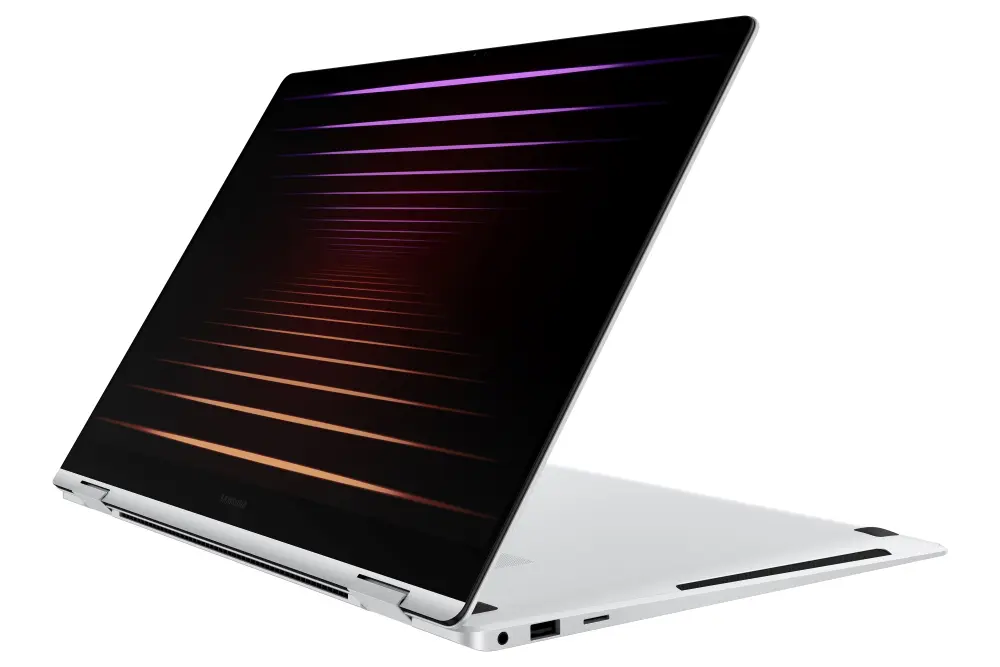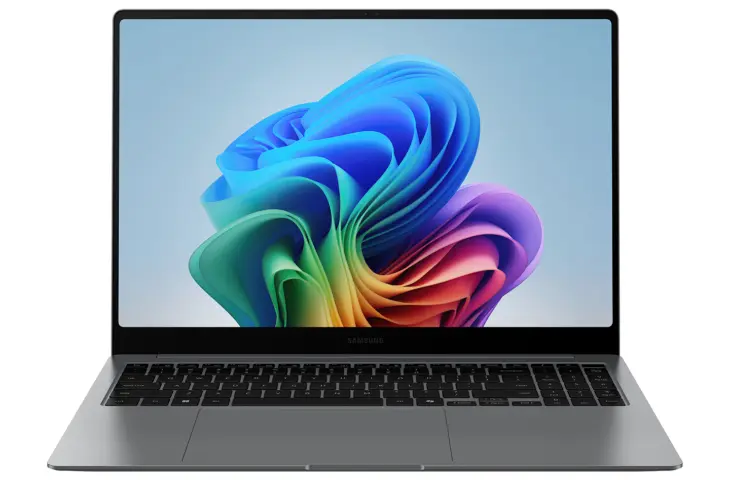The Samsung Galaxy Book5 Pro is an excellent business laptop, but lacks the proper equipment to justify the Pro label assigned by the manufacturer.
The Galaxy Book5 is the latest generation of Samsung laptops. The device is available in two variations, with the addition of the word Pro to one of the two models being the biggest difference between them. For this review, we worked with the Pro variant.
The Pro label is sometimes used inappropriately in the IT world today, but in principle, it indicates that the manufacturer wants to appeal to business users. A device that’s ‘Pro’ should therefore have sufficient distinction from the base model. With the Galaxy Book5 Pro, Samsung only partially makes up to that promise, thus overreaching with what could have been an excellent business PC.
Large Trackpad
The Samsung Galaxy Book5 Pro is for lovers of large laptops. You can’t just tuck away the 16-inch laptop in a small bag, but Samsung manages to keep the total package at a respectable 1.6 kilograms. When opened, the enormous trackpad immediately stands out.
The trackpad gets a lot of space in proportion to the keyboard (including numeric keypad) which sits more cramped together. You might occasionally mistake the mouse button because the trackpad surface is larger than you’re used to, although the trackpad and keyboard are generally convenient to use. In terms of ports, you won’t be short with 1x USB-A, 2x USB-C, 1x HDMI, 1x microSD, and an audio connection.
Tiltable Screen
The Galaxy Book 5 Pro is available with or without a screen that can be tilted 360°. Samsung provides a stylus for when you want to use the device in tablet mode. Unlike some 2-in-1 models, with the Galaxy Book 5 Pro you get a proper laptop that can be transformed into a (not so portable) tablet.

Samsung knows how to make a screen. High-end devices from the manufacturer are always equipped with a beautiful screen. The large 16-inch OLED screen provides sharp (2,880 x 1,800 pixels), vibrant, and colorful images that will appeal to you during both work and leisure. We see some higher DeltaE deviations on red and blue tones, while black tones are a particular strength of OLED screens.
The glossy screen can be annoying when a lot of light falls on it, as the reflection of light reduces visibility. The brightness at 389 nits is certainly not bad, but if you want to sit outside on a sunny spring day, it’s best to seek shade or place a hood over the screen.
Efficiency Over Power
After a brief flirt with Qualcomm with the Samsung Galaxy Book4 Edge, the manufacturer resolutely chooses Intel again. The Galaxy Book5 Pro is, along with others like the Dell Pro Premium, one of the first laptops with the Intel Lunar Lake generation. Samsung specifically chooses the Intel Core Ultra 7 256V. This is not the most powerful chip from the Lunar Lake family, as the chip is built primarily with efficiency in mind.
This choice doesn’t necessarily mean you sacrifice much computing power. We already thoroughly examined the new Intel generation, and none of the processors in the series disappointed. Intel is forgiven for the slip-up of Meteor Lake. Although the Intel Core Ultra 7 256V doesn’t possess the pure computing power of the Qualcomm Snapdragon 8 Elite, it’s a competitive processor.

This conclusion is confirmed in a simulation for commonly used Microsoft applications. In a direct comparison with similar Intel and Qualcomm devices, Samsung doesn’t emerge as the standout performer from the test. Take the numbers for what they are: in practice, this laptop offers excellent performance for office work. If you want the most powerful laptop of the moment, you’ll have to look for another device.

OLED Drains Battery
Is the Intel processor really that efficient? The question doesn’t have a simple yes/no answer. We already saw with the Dell Pro Premium that the Lunar Lake architecture enables very long battery life. In tests with continuous processor load as well as in a test with ‘idle’, Dell’s laptop lasted up to 24 hours or longer.
The Samsung Galaxy Book5 Pro doesn’t reach that level. The laptop achieves 15 hours in a test without idle and 16.5 hours with idle. The fact that the difference seems so large here has less to do with the processor and battery capacity (76 W). The flashy OLED screen is a game-changer here, as it demands more from the battery than a classic IPS panel. A large battery or energy-efficient processor can only partially compensate for that. Put the numbers back into perspective: if you were to work for 15 hours straight, your battery would deplete sooner than your laptop’s.

Where Samsung doesn’t deserve any grace is the slow charging time of the Galaxy Book5 Pro. Charging to fifty percent takes more than an hour, and for eighty percent, you can count on 106 minutes. That’s significantly slower than competing devices and, above all, a recurring problem for Samsung. The brand’s smartphones, from high-end to low-end, are also known for slow charging times.
AI Marketing
With the Galaxy Book5 Pro, Samsung is fully participating in the AI PC marketing hype. The manufacturer can do this thanks to the presence of the Intel Lunar Lake processor, approved by Microsoft as Copilot-compatible. In practice, all these labels still mean very little.
AI Select is essentially nothing more than a laptop version of Google’s Circle to Search for smartphones. The function works very well with a stylus, but you still need internet to perform a search and thus requires little local computing power. Photo editing functions do happen locally, as does applying filters during video conferences, to relieve CPU and battery strain.
Other AI functions pushed under the Galaxy AI banner are often found under a different name on premium smartphones or other Copilot laptops. Don’t be misled by Samsung’s marketing: the presence of AI is not an exclusive reason to buy the Galaxy Book5 Pro.
Sometimes Professional, Sometimes Not
Samsung completely misses the mark with some choices. The fact that the Galaxy Book5 Pro comes with Windows 11 Home is at odds with the Pro label attached to the device. This is where Samsung could have drawn a clear line between the Pro and non-Pro variants. Both devices have the same internals and software, so apart from the display, there’s hardly any distinction. This shows how little value Samsung attaches to the Pro label.
For a business laptop that would cost you around 2,000 euros depending on the configuration, we could have expected a better webcam. The 2 MP webcam is significantly lower quality than the webcam in professional devices from HP and Dell. For hybrid professionals, a good integrated webcam is not an unnecessary luxury, but Samsung hasn’t understood that message yet and considers a webcam a peripheral issue.
Productive, but Not Pro
This summarizes our verdict of the Samsung Galaxy Book5 Pro. This device has all the necessary ingredients for an excellent work laptop. The screen is a feast for the eyes, and in pure computing power, the device falls just below the top performers, but the average office worker will not be lacking anything. In battery life too, the Galaxy Book5 Pro is not the absolute standout, but you get more than what’s necessary.
This laptop is productive, but we can’t call it a professional device. For this, Samsung makes wrong choices on the margins to justify the Pro label, no matter how much AI the manufacturer wants to add. The Galaxy Book5 Pro wears a business suit, but no has no business blood flowing in its veins.
Samsung Galaxy Book5 Pro – Tested configuration: Intel Core Ultra 7 256V, 16 GB RAM, 1 TB SSD, 16 inch OLED screen (2,880 x 1,800), Windows 11 Home – 1,734 euros excl. VAT (from 1,900 euros excl. VAT for base model) – 36 months warranty
.pro’s
- Large, but not heavy
- Brilliant OLED screen
- Good performance for average office work
- Excellent battery life
.contra’s
- Slow charging
- Low webcam resolution
- Not fully professional
